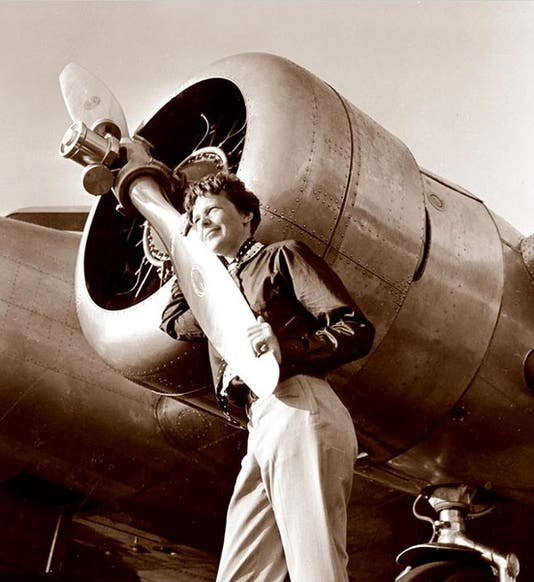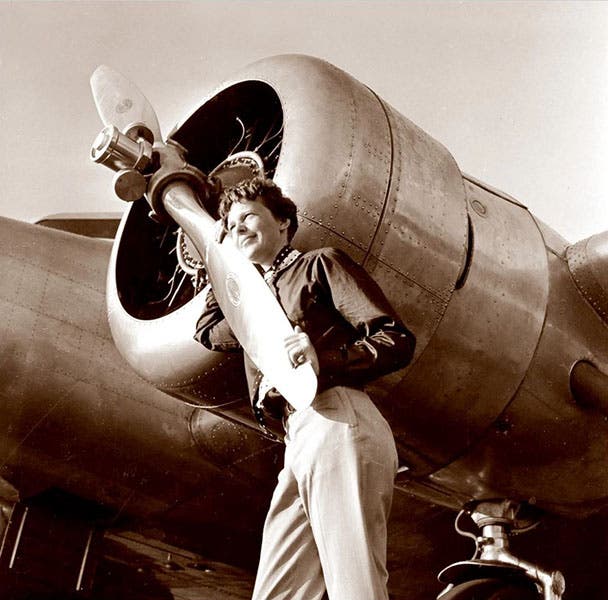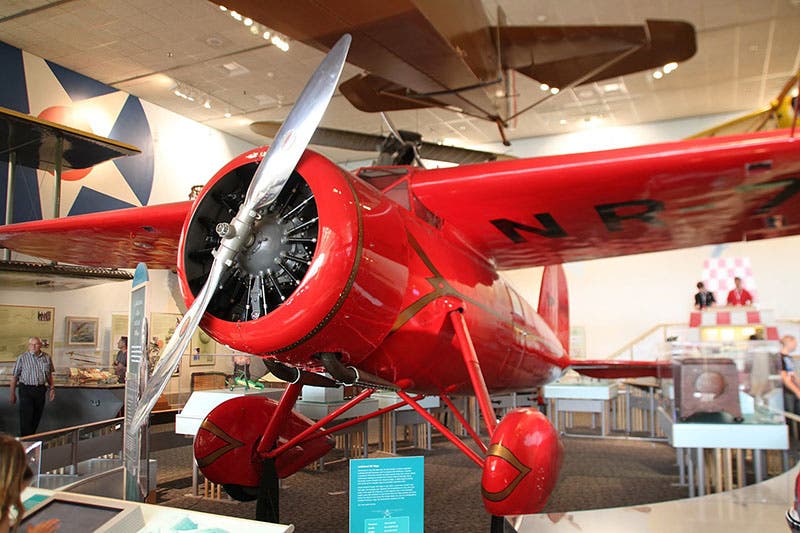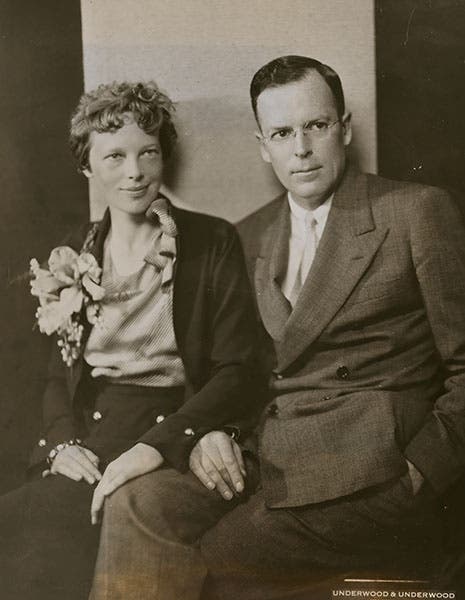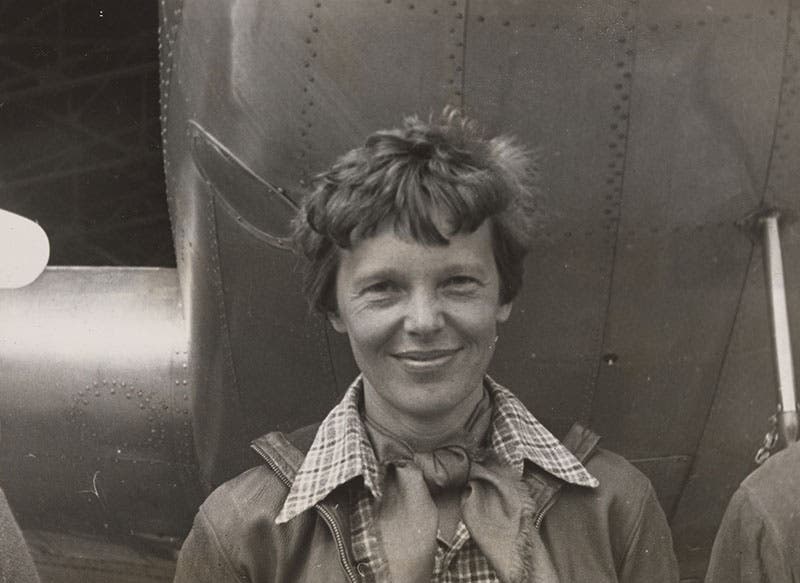Scientist of the Day - Amelia Earhart
Amelia Mary Earhart, an American aviator, was born July 24, 1897, in Atchison, Kansas. She was an adventuresome spirit from childhood, a childhood spent in Atchinson, Des Moines, Chicago, and California, as her alcoholic father moved from place to place seeking work on the railroads. The first time she saw an airplane, she was hooked. She worked hard to scrape up the money for flying lessons (one dollar per minute), and the inheritance from her wealthy maternal grandparents in Atchison helped, but that soon was used up, and she was on her own. She received her pilot's license in 1923 (second image), and soon scraped up the money to buy her own plane. After her parents finally divorced, she moved with he mother back to Boston, where she took a job as a social worker in a Boston settlement house, and she continued to fly.
In 1928, a pair of male flyers intended to fly across the Atlantic and thought it might be good publicity to take a woman with them. New York City publisher George Putnam got wind of the scheme and took charge. Casting about for a suitable charismatic woman pilot, his agents heard about Earhart and approached her. She was eager to take part, even if her only responsibility was to keep the log. Putnam knew his business, and Earhart knew how to charm the press; the flight was a success, and she became famous in the United States as the first woman to cross the Atlantic in a plane, even though, as she said, she was nothing more than a “sack of potatoes” on the flight. Earhart went on a long speaking tour, organized by Putnam, and she was enormously popular, with her self-effacing manner and sinewy good looks and disdain for conventional women's apparel.
Earhart also showed that she could be more than a passenger, making the first solo coast-to-coast flight by a woman, and several other long solo flights. Earhart had been adamant since her younger days that women could do anything men could do, especially in the air, and there was no reason why women could not fly commercial aircraft, even though they were not allowed to at the time. In 1929, she asked a number of her fellow female pilots if they wanted to form an organization (there were many such pilots, more than you would think – she sent out 117 invitations). Ninety-nine responded "yes," and so the "Ninety-Nines" was founded, with Earhart as its first president. The Ninety-Nines is still a thriving organization of women pilots.
In 1931, Putnam and Earhart were married (fourth image). In was from the outset a marriage of convenience, but it seems to have functioned well enough for both. It was probably the only kind of marriage possible for someone like Earhart, who could not abide stasis.
On May 20, 1932, Earhart took off from Newfoundland in a Lockheed Vega 5B, with the intention of flying solo across the Atlantic to Paris, just as Charles Lindberg had done five years earlier (third image). It was a rough crossing, and almost 15 hours after she departed, she landed in a field in Northern Ireland. It wasn't Paris, but it was across the Atlantic, making her the first woman to accomplish the feat of a solo trans-Atlantic flight. Earhart was now a world celebrity. It is often said that in 1933, Earhart was the most famous woman in America, and looking at photos of the crowds of hundreds of thousands that came out for every parade featuring Earhart, I would not doubt it. She used her fame to push for women's rights in the workplace. She became good friends with Eleanor Roosevelt, who had similar aims with regards to promoting the capabilities of women in fields then dominated by men (fifth image).
Earhart also continued to race. She was by no means the best woman pilot in the states from 1933 to 1937; one could make the case that Ruth Elder, Ruth Nichols, Florence Klingensmith, and Louise Thaden were better aviators. In 1935, the Bendix cross-country race was opened up to women for the first time, and Earhart finished fourth. But in 1936, the Bendix Trophy was won by Louise Thaden, with Blanche Noyes as co-pilot, the two women beating all the men in the race, which was a great moment for the Ninety-Nines. But for all the skill exhibited by scores of women pilots, Amelia Earhart was the face of female aviation up to her death, and then for decades thereafter.
By 1937, Earhart was hard-pressed to find something new to do in an airplane. She opted for an around-the-world flight at the equator, which had never been done. The aircraft was a Lockheed L10 Electra (sixth image). The flight was well-planned, although the first attempt had to be called off when the aircraft was damaged in Hawaii. The second attempt left Miami on June 1, 1937, flying east, and made it, with various stops along the way, to Lae Airfield in Papua New Guinea, about 22,000 miles from their starting point, with about 7,000 miles left to fly. Fred Noonan, navigator, was the other individual on board with Earhart. They left Lae on July 2, headed for Howland Island 2000 miles away in the Pacific, and never arrived. A month later, Earhart and Noonan were officially presumed dead. Most likely the aircraft crashed and sank, but there are dozens of other theories, if you wish to pursue them. I do not. The bottom line is that Amelia Earhart, pioneering woman aviator, was dead, at age 39. She had given the women of America something to aspire to and feel pride in for 9 years, and that is an enviable legacy.
Amelia Earhart’s grandparents’ home in Atchison, where she was born, was purchased by the Ninety-Nines and is now a museum; here is their webpage. A second museum, called the Amelia Earhart Hangar Museum, opened in Atchison just this spring (April 2023); here is that website. I have not been to either museum, although I hope to get to both very soon. The National Portrait Gallery at the Smithsonian Institution has an excellent collection of photographs of Earhart, upon which I have drawn for this post. You may see thumbnails of all of them (on two pages) at this link. The Lockheed Vega 5B in which Earhart soloed across the Atlantic in 1932 may be seen in the National Air and Space Museum in Washington, D.C. (third image).
William B. Ashworth, Jr., Consultant for the History of Science, Linda Hall Library and Associate Professor emeritus, Department of History, University of Missouri-Kansas City. Comments or corrections are welcome; please direct to ashworthw@umkc.edu.

